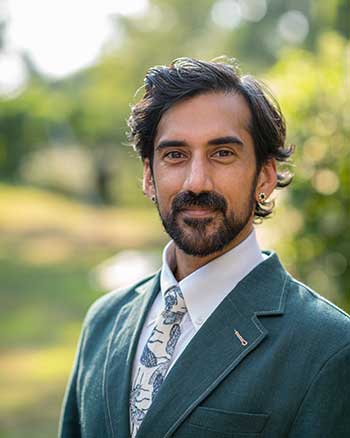Siddhartha V. Shah Begins Tenure as New Mead Director

Siddhartha V. Shah assumed the position of John Wieland 1958 director of the Mead Art Museum on Tuesday, Nov. 15.
Coming to Amherst after a stint as curator and head of education and civic engagement at the Peabody Essex Museum (PEM) in Salem, Massachusetts, Shah says that he hopes to foster integration between the museum and the broader campus community in his role as director, while promoting projects that reflect the student body and its values.
The college officially announced on Aug. 10 that Shah would be assuming the directorship. In his position as director, Shah will oversee a wide range of responsibilities, from overseeing the museum’s collections, exhibitions, and fundraising, to helping faculty develop curricula, to promoting student involvement with the museum.
The Mead has lacked an official director since David Little’s departure in the fall of 2021. Associate Professor of Russian and Director of the Amherst Center for Russian Culture Michael Kunichika served as interim director during the search for a long-term replacement.
Shah brings to Amherst a deep passion for community engagement, most recently displayed in his work at the PEM, where he championed outreach through educational programs and student internships while also managing the museum’s art collections and developing exhibitions.
Shah told The Student that one of his primary motivations for accepting the position at Amherst was the opportunity it afforded to work closely with students, faculty, and staff to develop and enhance curricular offerings while also curating exhibitions that appeal to the college community and broader public. “Those are my personal and my professional interests, and those things can come together when you work at a college museum,” he said. Shah was also drawn to the college’s liberal arts model. “The idea of a community that is prioritizing the arts was really important to me.”
In light of his dedication to outreach and education, Shah expressed that what he most looks forward to about his new duties as director is the opportunity and challenge of facilitating the museum’s integration into the broader community, and molding the museum itself into a space where students can see their identities and life experiences reflected. “[The fact] that the museum could be a space where we could bring the intellectual [together] with the creative and engage students’ or anybody’s life experiences or identities really excites me,” he noted.
Part of Shah’s vision in realizing a space that both welcomes and challenges the community is the emphasis that he hopes to place on diversity and inclusion through the museum’s projects, specifically through projects that highlight a wide variety of various aspects of the student body and allow a broader audience to connect to and find meaning in art.
Shah recalled a formative experience in his work at the PEM that has shaped the way he approaches curation. Having formulated an installation on India and the country’s independence movement, he noted that the exhibition connected deeply with a wide range of people, many of whom had little personal connection to South Asia. “They could relate to a history of colonialism, and by seeing a gallery full of dark bodies other people could relate to this history of colonialism and the importance of racial representation,” he said.
Executing projects that reflect the experiences of the student body accurately will be a process that includes existing artifacts and artwork at the Mead, in addition to acquiring new objects that reflect different parts of the world and moments in time that are not currently represented in its collections.
“I believe in the importance of diversifying art collections, and that collections should reflect the community, wherever the museum is,” Shah stated. “But I also think that there are countless stories that can be told with whatever collections museums have, they just need to prioritize the kinds of stories and conversations that you can have with them, not the preciousness of the object.”
Shah also conveyed his hope that the museum can be a space that reaches the community in ways that go beyond the intellectual, something that can be otherwise neglected in intense intellectual environments like Amherst’s.
“I think that there can be a lot more humor and joy in museums,” he said. “In general, we’re living such stress[ful] lives, and you have a lot on your mind and a lot to do. And I think I’m going to try to bring an emphasis on the museum as a space of joy and humor with me.”
Shah also emphasized his desire to create space for spirituality within the museum, albeit not in the traditional sense. “I’m not necessarily talking about focusing on organized religion, or the new age. I’m talking about empathy, connection, and wellness,” he explained. “I think that museums can be a place where people can find hope, be better citizens, and learn to manage their stress and anxiety. I hope to make that a real priority.”
As Shah works to develop stories that meet the needs of the college, he hopes to actively connect with a wide variety of its members, especially students, to understand the various perspectives that they embody and the hopes and suggestions that they have for the Mead going forward. “I want this to be a respite for people, so I want to find out what they want.”